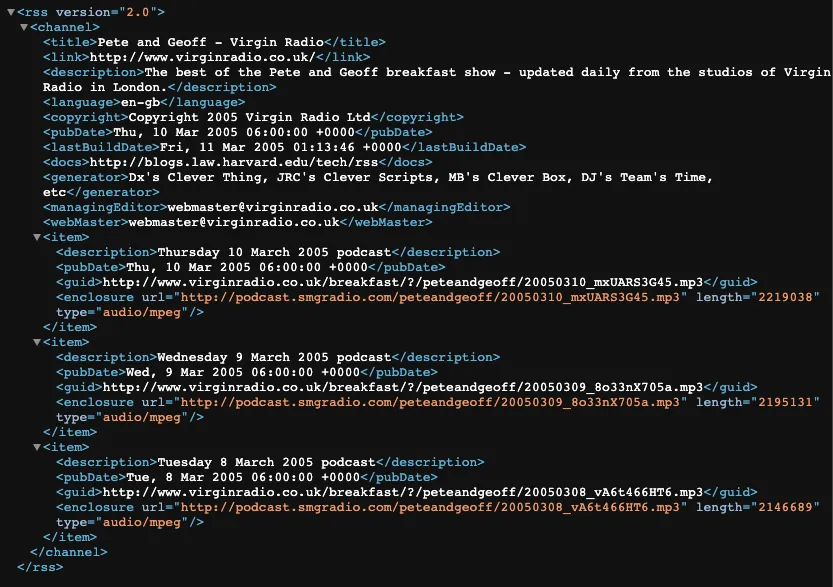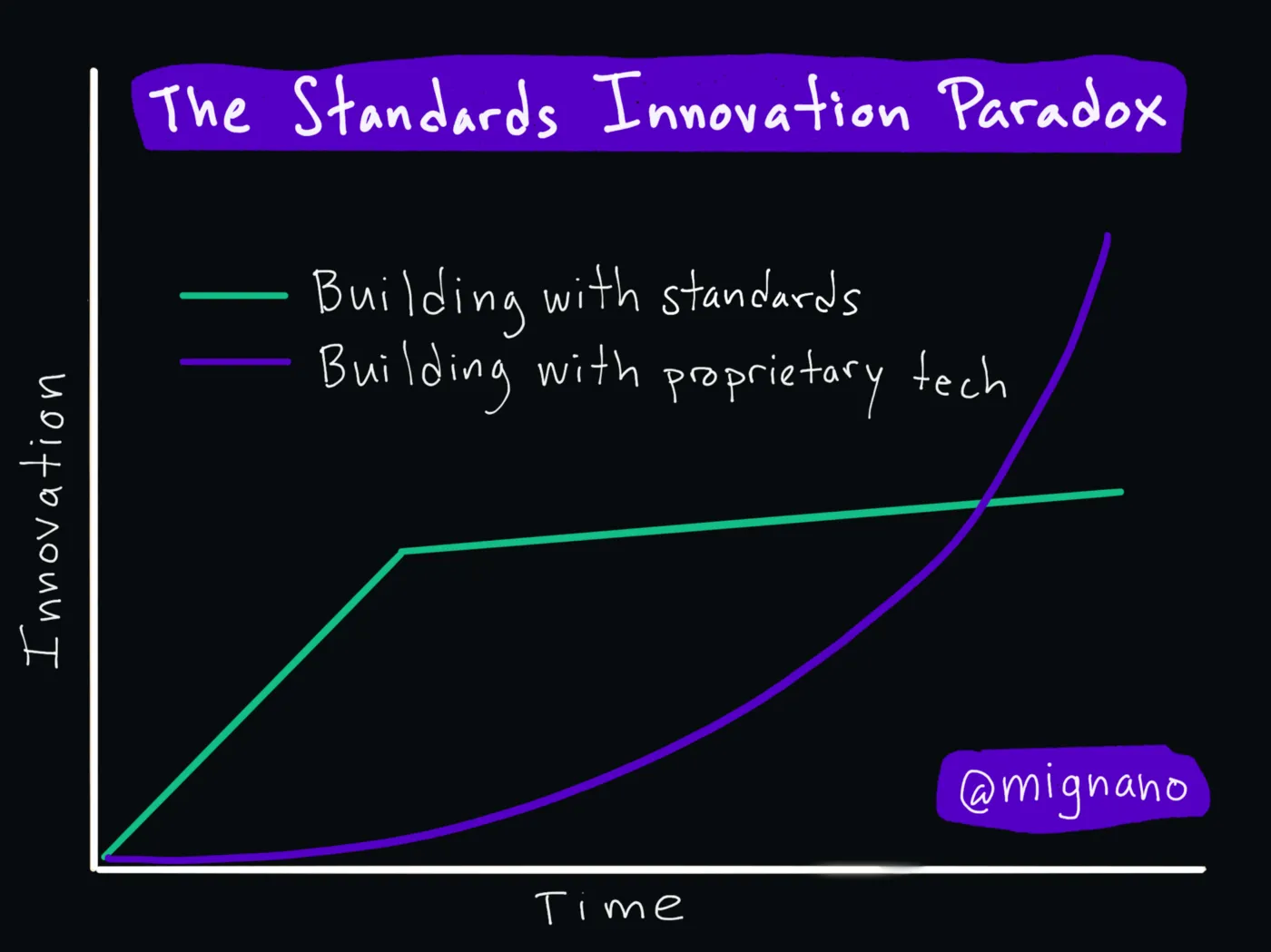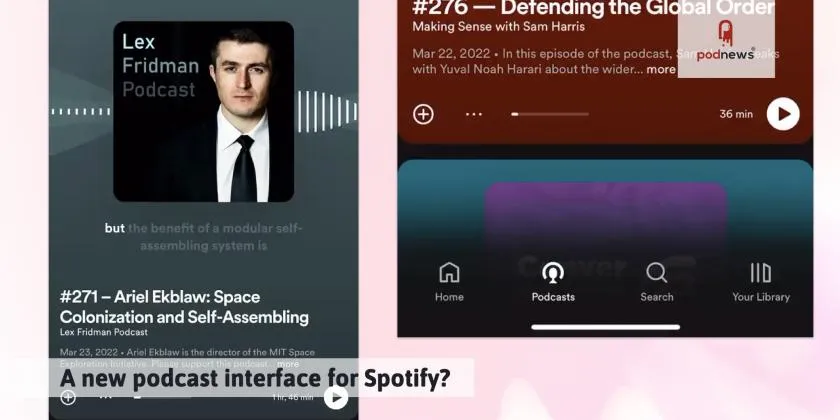The Standards Innovation Paradox: is it real?
Michael Mignano, the co-founder of Anchor, wrote a piece here on Medium about what he calls The Standards Innovation Paradox. Here it is:
The Standards Innovation Paradox
_Standards, like RSS for podcasts, have enabled emerging technologies to spread far and wide in the information age by…_mignano.medium.com
It’s a good piece, and worth a read.
In the article, the person who went on to look after podcasting within Spotify for a number of years — he left in June this year — has some irritating things to say about podcasting, notably “the podcast format has remained mostly stagnant over its 20 year history”. But that’s the bluster you’d expect from a former Spotify exec who’d like his share price to go up a little.
Naturally, this comment has irritated “the podfather” himself, who’s tweeted (and pinned)…
Ouch.
For a start, and yes, I will be this pedantic, podcasting doesn’t have a 20 year history. It’s either 19 or 21 years old, say the dates: depending whether you age it by “the first piece of audio in an enclosure tag in an RSS feed” (Jan 20, 2001) or “the first recording specifically distributed using an enclosure tag in an RSS feed” (July 9, 2003). Glad I got that off my chest.
But, it’s also seen some innovation and enhancement over its 19/21 year history, too: and most certainly hasn’t remained stagnant.
You’re not so stagnant now
Here’s a podcast RSS feed from March 2005 (which, to declare an interest, I wrote).

Now, if you look carefully at it, you’ll notice a few things that are missing. The two most obvious: there are no thumbnail images, and no categories.
Mignano describes standards as difficult to work with because:
If you plow ahead with the change anyway and break the standard, then you lose the benefits of the standard.
However, the benefit of RSS feeds are that you can add additional “namespaces”, which can power additional features without breaking the standards.
Apple put podcasting into iTunes in June 2005, and with it, they added their own namespace, which added additional tags for things like show artwork. They also took it upon themselves to define a list of categories, which they last updated in 2019.
Apple added these new tags because it enhanced the experience; and because podcasters saw the benefit in them (aided by the refusal of Apple to accept shows without artwork in the right format, a thing podcasters have fun with even today).
Imagine a podcast app today without those ubiquitous thumbnails: items that weren’t in the original podcast RSS specification.
Moving, keep on moving
In June 2017, Apple innovated the standard again: adding a set of new tags. Now, you can mark that an episode is a “trailer”, or whether the show should be listened-to in chronological order. The new tags also include episode numbers and other things.
By and large, most podcasters have adopted these new tags, because, again, they can see the benefit in them. And many other podcast apps have also supported the tags, too.
Apple could evolve the specification because the iTunes namespace, which all podcast RSS feeds use, enables Apple to add more tags without breaking anything for anyone else.
Apple could also evolve the specification because it has a market share of around 40% of all listening: so podcasters know that when they implement a new tag, it has a benefit for a large segment of their audience.
Mignano says:
Anytime a team wants to do something exciting and new that exceeds the limitations of the standard, they have to get every stakeholder (or at least enough to reach a critical mass of adoption) who has adopted that standard to also adopt the change, otherwise the change is useless.
…but the evidence here is scant. Apple added these new tags, which don’t break the standard. Some, poor, podcast apps (and hosts) still don’t support some of these new tags: but that doesn’t mean the change was useless. Apple got first-mover advantage, and supported these tags before anyone else. Spotify supports some, too.
Don’t stop me now, ‘cause I’m having a good time
And, step forward The Podcast Index, which has formalised a bunch more new tags in the so-called “new podcast namespace”. New tags exist for all kinds of new things in podcasting: from video versions of audio files (the alternateEnclosuretag), a method of potentially combatting unauthorised copying of shows (the locked tag), to full transcripts (the, you’ve guessed it, transcript tag).
These new tags enable all kinds of new functionality for podcasting, and have been very quickly implemented by a set of new podcast apps and providers.
Some tags, like the transcript tag, are elegant solutions to thorny problems that podcasting has had for a while; and enables creator control of transcripts which are useful for brand-safety and content analysis as well as the more obvious benefits for those who are deaf or hard of hearing.
They don’t, however, have the mass takeup that you’d only get from big supporters, like Apple or Spotify.
Like Apple.
Or Spotify.
Or Spotify.
Or Spotify.
Hmm.
Here’s where The Standards Innovation Paradox can be fixed

Michael Mignano’s graph here is persuasive.
But, I think, it shows that his last few years at Spotify were quite trying: because he was surrounded by people who didn’t fully understand what’s possible with RSS.

During his tenure, the company (re-)launched video podcasting. An elegant solution, and better than the current kludge of a separate RSS feed for video, the way Spotify podcasts work is there are two separate files which you can switch between: an audio file, and an alternateEnclosure of a video file for the same asset.
Spotify decided the way they’d implement this was to throw away RSS, and implement a proprietary black-box. That had the benefit of locking users who wanted to produce video podcasts into hosting with Anchor: but it appears that Mignano’s thought pattern was “we have to build it with proprietary tech because we can’t evolve the standard”.
Yet, Spotify absolutely could evolve the standard: because by April 2022, they were big enough, with at least 30% market share, to have set the standard themselves.
They could have said “here’s how to signal the video asset in your RSS feed, and if you do this, you’ll get video podcasts in Spotify too.” They could have looked at the currently existing solution to this, the podcast namespace’s [alternateEnclosure](https://github.com/Podcastindex-org/podcast-namespace/blob/main/docs/1.0.md#transcript) tag, and adopted that (and, possibly, moulded it to their needs). But, they didn’t.
So, is this the “standards innovation paradox” at work? Is it just laziness? Or is it a desire to lock podcasters into using Anchor?

During his tenure, the company added transcripts for some shows in a new podcast interface that they were testing. They’re using machine-transcripts, which aren’t always accurate; but also aren’t within the creator’s control. To accuse a mining company boss of “beating miners” is one thing; to accuse them of “beating minors” is quite another.
But, by March 2022, Spotify was big enough, with at least 30% market share, to have specified how to do this themselves. They could have looked at the existing transcript tag, decided which format they wanted to support, and adopted that. But, they didn’t.
So, is this the “standards innovation paradox” at work? Is it just laziness? Or is it an uncharacteristic lack of confidence by Spotify?
The Standards Innovation Paradox doesn’t exist with RSS
Now, sure, if you want to try to change the email standard, good luck with that (though Google’s AMP-mail, which adds interactivity to emails while also maintaining backwards-compatibility seems to be working well: given they own a sizeable market share in Gmail).
But with RSS, you can evolve the standard, using additional namespaces which don’t break the specification; and if you’re big enough, or you believe in yourself enough, you can ensure all podcast publishers implement them. Just ask Apple.
Podnews’s RSS includes a bunch of the very new tags and features Mignano tells us are impossible: yet, oh, look, the very same RSS feed is also powering a very familiar podcast player indeed, with no breakages or failures because of the new features that have also been enabled.
So is The Standards Innovation Paradox a thing?
The next time someone asks you about The Standards Innovation Paradox, ask them: is it absolutely true that you can’t mould the standard to make it better for everyone?
Or is it, in truth, a lazy developer or an under-resourced product manager trying to tell you that something can’t be done to make life easier for themselves?
Or, worse, a senior manager looking to build product lock-in?
James is Editor of Podnews, a podcasting newsletter
— — — — —
LATER:
Alberto Betella weighs in, with a better graph!
Innovation in podcasting
_Back in 2006, I built an open-source web app called Podcast Generator, which quickly became one of the most popular…_medium.com
Michael Mignano joins me on the Podland podcast this week to discuss his piece further.